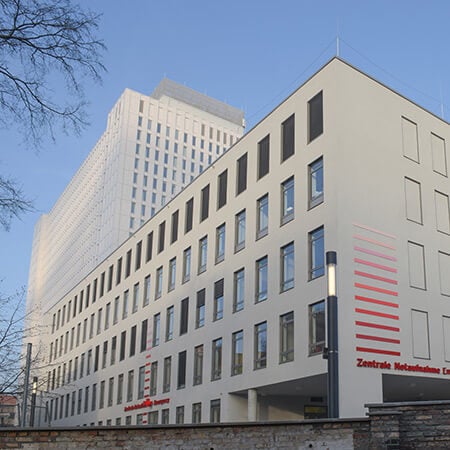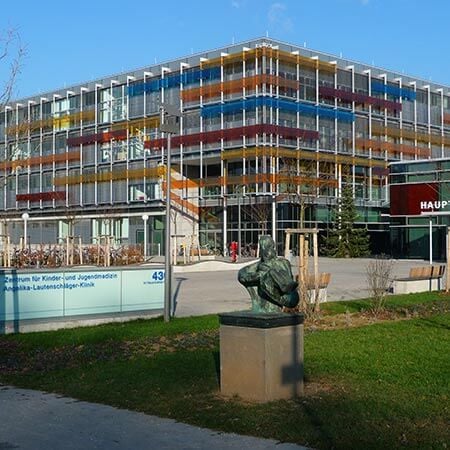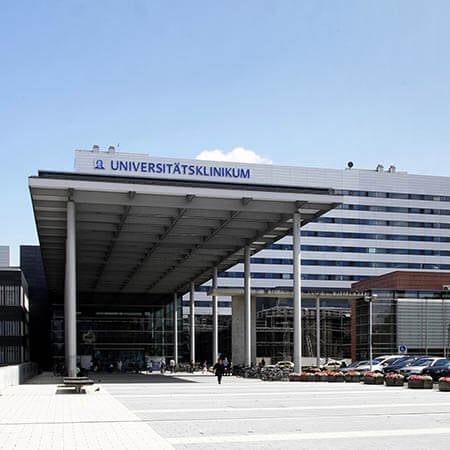Fournier gangrene, or fulminant perineal gangrene, is a severe infectious disease that develops mainly in the elderly due to immunodeficiency, alcoholism, obesity, and concomitant internal diseases. The condition has a bacterial origin. This is an acute pathology requiring emergency medical care. Timely diagnosis and early treatment are the keys to saving the patient's life and the function of the pelvic organs. You can undergo treatment of Fournier gangrene in Germany to expect the best results. You are welcome to visit the Booking Health website to find the cost of treatment in Germany and make your appointment at a hospital. The specialists from the Booking Health company will help you to arrange your trip as soon as possible.
Content
- Diagnosis
- How dangerous is the disease?
- Treatment
- Why is it worth undergoing treatment in Germany?
Diagnosis
An early diagnosis is very important for patients with Fournier gangrene, as it increases the chance of a favorable outcome for the disease. Unfortunately, the average hospital stay for this pathology is 8 days, and up to 80% of patients are admitted to the hospital more than 3 days after the onset of the first symptoms.
The very first signs of the disease are as follows:
- scrotal swelling;
- pain;
- redness;
- fever.
It takes an average of 5-7 days before necrotic processes begin. The first sign of tissue death is the appearance of black spots on the scrotal skin. Their diameter is much smaller than the subcutaneous tissue necrosis area ("tip of the iceberg" phenomenon). During clinical diagnosis, a doctor notes the accumulation of air in the scrotum (gasses are produced by anaerobic flora).
Six LRINEC laboratory criteria are used for the timely diagnosis of the disease. This score assigns scores and places the patient in one of three risk groups for necrotizing infection, depending on blood leukocyte, hemoglobin, sodium, glucose, creatinine, and C-reactive protein levels. If the score is more than eight, the risk of Fournier gangrene is 75%.
The diagnosis can be confirmed with a biopsy. This is a minor operation during which doctors take a small piece of tissue for a histological examination. If the diagnosis is confirmed, the extent of surgery can be immediately expanded to include a necrectomy (surgical removal of dead tissues).
Radiological diagnostic methods are not considered mandatory, but they can be used in doubtful cases to determine indications for a biopsy. These methods also help doctors to plan an operation by assessing the depth of tissue damage. The best diagnostic options are CT and MRI scans, as their accuracy reaches 98%.
How dangerous is the disease?
Fournier gangrene is treated on an inpatient basis. An early diagnosis is very important. The earlier treatment is started, the better the prognosis. If diagnosed late, the prognosis is poor. It is very difficult to treat the advanced stages of the disease, and the mortality rate of patients is quite high.
Unfavorable prognosis factors include the following:
- tissue lesions outside the perineum;
- severe sepsis or septic shock;
- a heart rate of more than 90 beats per minute;
- leukocyte counts are greater than 20*109/l;
- urea levels are above 7 mmol/l.
The outcome of the disease depends not only on the timing of diagnosis and the severity of the pathology, but also on the quality of medical care provided. Trails have demonstrated a lower mortality in patients with Fournier gangrene at specialized medical centers due to more adequate treatment and care. If you are going to undergo your treatment of Fournier gangrene in Germany, it is better to seek medical attention from university hospitals. Doctors at university medical centers use the most advanced treatment methods and the latest patient management protocols. The specialists from the Booking Health company will help you to select hospitals in Germany that demonstrate the best statistics on the effectiveness of Fournier gangrene treatment.
Treatment
The basis of therapy for Fournier gangrene is urgent surgery combined with antibacterial and detoxification therapy.
Surgical treatment
Surgical debridement, during which all necrotic tissues are removed, is the mainstay of treatment for Fournier gangrene. Doctors perform resection until viable tissue is found.
Fournier gangrene rarely requires a single operation because doctors usually perform several surgical procedures. Their overall numbers can be up to eight. On average, one patient undergoes four surgical procedures to remove dead tissue.
The elimination of the infectious process is followed by restorative surgical treatment. It begins after the formation of granulation tissue. Surgery includes skin grafting with local tissues, autodermoplasty with split skin grafts, muscle grafting, and various combinations of these techniques. Plastic and reconstructive surgical interventions allow doctors to restore the normal appearance of the perineum and the function of affected organs. The rectum and scrotum are most often affected among them. Many patients require surgery to divert urine.
Anti-shock therapy
Many patients are admitted to the hospital with septic shock. They require correction of their hemodynamics (blood circulation). It normalizes cardiac activity, improves tissue oxygenation, removes toxins, and avoids the development of multiple organ dysfunction.
Patients undergoing their treatment at hospitals in Germany receive massive infusion therapy. Vasopressors can be used to increase blood pressure and ensure normal blood supply to the organs whenever required. Some patients require measures to correct their blood pH. Anti-shock therapy is carried out under the control of laboratory and hemodynamic parameters in the intensive care unit.
Antibiotics
Fournier gangrene is a bacterial infection. The treatment for this condition therefore includes antibiotic therapy. The earlier it is provided, the better the result. Initially, the drugs are administered intravenously, but after the patient's condition improves, doctors switch the patient to oral administration of medications.
Given the polymicrobial (aerobic and anaerobic) etiology of the disease, 2-nd and 3-rd generation cephalosporins with antibiotics from the group of nitroimidazole, fluoroquinolones, and aminoglycosides are considered the drugs of choice for the antibiotic therapy for Fournier gangrene. Doctors at university hospitals in Germany treat severe forms of the pathology with carbapenems.
Antibiotics are first given empirically (based on past experience of gangrene treatment). However, after a few days, doctors receive the results of bacteriological diagnostics with an antibiogram. Based on the results, the specialists from hospitals in Germany receive data on the sensitivity of the microflora to various antibacterial agents and can adjust a treatment regimen taking these date into account if the initial therapy is not effective enough.
Vacuum therapy
Healthcare professionals at hospitals in Germany use vacuum therapy for additional treatment of extensive wounds. Doctors use negative pressure of about 125 mmHg.
The technique is used in the second phase of the wound process (the dehydration phase), after performing the required number of operations to remove dead tissues. The procedure allows doctors to clean the wound and ensure the full formation of granulation tissue. It also removes bacteria and their toxins.
The effects of vacuum therapy are below:
- edema reduction;
- improved blood circulation;
- normalization of local immunity;
- wound cleansing.
The technique can be applied to any, even anatomically complex body surface. The treatment procedure is well tolerated by patients and does not cause any side effects.
Hyperbaric oxygen therapy
Many university hospitals in Germany have pressure chambers. Hyperbaric oxygen therapy can be used as an additional treatment method. The procedure involves the injection of oxygen at a pressure of 2.5 absolute atmospheres. A patient stays in the pressure chamber for 90-120 minutes per session.
The effects of treatment in the pressure chamber are as follows:
- improved blood oxygen saturation;
- increased activity of immune cells in the area of inflammation;
- prevention of further gangrene spread;
- reduced body poisoning with tissue decay products;
- direct destruction of clostridia due to the formation of free forms of oxygen;
- better effectiveness of aminoglycosides due to their better penetration into cells (such antibiotics are especially effective against Pseudomonas aeruginosa).
Hyperbaric oxygen therapy improves wound healing and reduces swelling. In addition, according to some studies, it reduces the mortality rate of patients. At the same time, the method is not mandatory. It often causes side effects, so it can only be used in hemodynamically stable patients.
Why is it worth undergoing treatment in Germany?
Hospitals in Germany have state-of-the-art equipment. They employ doctors who are considered among the best in the world. There are a few reasons for you to undergo diagnostics and treatment in Germany. These are as follows:
- high-precision diagnostics that allows doctors to perfectly plan treatment tactics;
- saving lives of most patients;
- the successful treatment of even severe forms of Fournier gangrene;
- comprehensive treatment that involves surgery, antibiotics, detoxification and anti-shock therapy, hyperbaric oxygen therapy, and vacuum therapy;
- the use of drugs and procedures for accelerated wound healing;
- at the second treatment stage, plastic and reconstructive surgical procedures are performed to divert urine and feces and to restore the normal appearance of the anogenital area;
- High-quality care and comprehensive rehabilitation.
You are welcome to visit the Booking Health website to find the cost of treatment in Germany and select the best hospital. You can get medical care at one of the university hospitals, which employ the best doctors in the country. Thespecialists from the Booking Health company will help you to select a hospital in Germany, reduce the waiting period for an appointment and arrange your trip. When making your appointment at the hospital through the Booking Health service, the cost of treatment in Germany will be lower due to the lack of additional coefficients for foreign patients.
Authors:
The article was edited by medical experts, board-certified doctors Dr. Nadezhda Ivanisova and Dr. Vadim Zhiliuk. For the treatment of the conditions referred to in the article, you must consult a doctor; the information in the article is not intended for self-medication!
Sources:
National Library of Medicine
Healthline
The Lancet




















